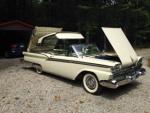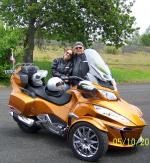|
-
Very Active Member

 Rear shock/air bag air pressure regulation by BUDS? Rear shock/air bag air pressure regulation by BUDS?
2014 RTS
I seem to remember reading in here that there is a setting in BUDS that governs how much air pressure is pumped into the air bag. The switch that shows different levels of air pressure must have some sort of parameter to go by if I understand. Can someone confirm this for me and what the max pressure is or should be? Is there a median amount or an amount for each of the settings?
Thanks,
Gary
 States visited by Bike
-
Very Active Member

 Position, not pressure. Position, not pressure.
Since the air bag basically functions as an adjustable spring - BRP even calls it an air spring - as the air pressure is changed in the bag, the frame position raises and lowers with respect to the swing arm. Now, the engineers could have used a pressure sensor to provide feedback for automatic control, but they used that change in frame position instead. So, look underneath on the left hand side above the belt and you'll see that sensor.
But as riders, we're interested in ride firmness - that is comfort. More air = harder, less air = softer. Just like air in a football as Tom Brady knows. When you adjust for a particular firmness, let's say the middle setting for example - and you're by yourself on the machine - the system will put in air pressure and bring the frame to that calibrated position. If you keep the firmness setting the same and add additional weight, add a passenger let's say, initially the frame will lower because of the additional weight. The position sensor sends that signal and the system will automatically add more air pressure and raise the frame back to the original middle position - with the theory being that the ride firmness will also be the same as it was with just you for that middle setting. So, as you can see, there will be varying air pressures at the same firmness setting all depending on the weight on the machine. And when your passenger gets off, the frame rises, the system vents air, and the frame position and firmness go back to the middle position - now at a lower air pressure.
So, what you do in BUDS is calibrate the frame position sensor to the various settings on the display, not to air pressure. It's not rocket science, just two lengths of wooden blocks - one corresponding to the lowest setting, and the other to the highest. Then the system takes care of the other three settings on the display.
So, there isn't just one air pressure corresponding to each of the settings on the display. The weight the air bag is supporting at that setting, will determine what the pressure will be in order to maintain that setting's frame position.
Last edited by Snowbelt Spyder; 06-19-2017 at 06:39 PM.

Doug
2023 RT Limited, RT 622, BUDS/BUD2 Megatech/Megatronic
”Freedom is not a loophole”
F4 Customs SWCV, Ultimate, Lidlox, Adjustable Side Vents, Leather Like Grips, SS Grills, Centramatic, Garmin XT2, BajaRon Original Sway Bar w/ Lamonster links, P238
-
Very Active Member


Thanks for the explanation Snowbelt Spyder. I am familiar with the sensor from the rear wheel removal procedure. For sake of clarification,
I have the hardness setting at the top, ie most firm. I measured the air pressure from the Schrader valve under the seat and it read 32 lbs with no one sitting on the seat. Presumably the pressure would read higher with my wife and I on the seat. That seemed quite low to me but maybe I'm completely wrong. Is it reasonable to assume that the system could be recalibrated to be at a higher pressure?
I increased the pressure to 50 lbs and it dropped to 48 but seems to hold there as I was initially concerned that the bag was loosing air. Doesn't seem to be the case.
Gary
 States visited by Bike
-
Very Active Member


At 32 pounds, with no one on the seat, your frame was at that full up position. Then when you get on and the frame lowers, the system adds additional air to return it to the full up position. So you end up with a higher pressure, supporting more weight, at the same position. In other words then, the system seeks a return to the proper position, based on weight. And the air pressure is whatever it takes to get there. No need to recalibrate to be at a higher pressure because it automatically takes care of that. You could say the system is frame position based, not air pressure based. There is no pressure sensor anywhere. And you don't want to extend the range of the position sensor excessively, or you have issues with the shock absorber reaching its limits of travel. The sensor calibration hi and low limits prevent that. Remember, as we travel down the road, the frame is always moving with respect to the swingarm. Too much air and it tops out the shock absorber.
Last edited by Snowbelt Spyder; 06-19-2017 at 09:33 PM.

Doug
2023 RT Limited, RT 622, BUDS/BUD2 Megatech/Megatronic
”Freedom is not a loophole”
F4 Customs SWCV, Ultimate, Lidlox, Adjustable Side Vents, Leather Like Grips, SS Grills, Centramatic, Garmin XT2, BajaRon Original Sway Bar w/ Lamonster links, P238
-
Very Active Member

 States visited by Bike
-
Very Active Member


Very good and detailed explanation.
2011 RTS (Sold to a very nice lady)
1998 Honda Valkyrie
2006 Mustang GT. Varooooom!
US Navy Veteran
SC Law Enforcement Boat Captain
CNC Machine Service Technician
President: Rolling Thunder SC1
Member: Disabled American Veterans, Rock Hill, SC
Member: American Legion
Experience is recognizing the same mistake every time you make it!  
-
Active Member


 Originally Posted by Snowbelt Spyder

At 32 pounds, with no one on the seat, your frame was at that full up position. Then when you get on and the frame lowers, the system adds additional air to return it to the full up position. So you end up with a higher pressure, supporting more weight, at the same position. In other words then, the system seeks a return to the proper position, based on weight. And the air pressure is whatever it takes to get there. No need to recalibrate to be at a higher pressure because it automatically takes care of that. You could say the system is frame position based, not air pressure based. There is no pressure sensor anywhere. And you don't want to extend the range of the position sensor excessively, or you have issues with the shock absorber reaching its limits of travel. The sensor calibration hi and low limits prevent that. Remember, as we travel down the road, the frame is always moving with respect to the swingarm. Too much air and it tops out the shock absorber.
My compressor has started cycling off and on a lot while on the road or sitting at a corner, etc. At home over night it currently has maintained 50PSI, so I "think" the bag is OK, but what would cause the cycling ?? PS, we always ride 2 up.
-
Very Active Member


 Originally Posted by teninospyder

My compressor has started cycling off and on a lot while on the road or sitting at a corner, etc. At home over night it currently has maintained 50PSI, so I "think" the bag is OK, but what would cause the cycling ?? PS, we always ride 2 up.
Besides the airbag, there are several other pieces to this system including plumbing and a valve that releases air if the system has too much. Spray the area with soapy water to see if there are any leaks.
2011 RTS (Sold to a very nice lady)
1998 Honda Valkyrie
2006 Mustang GT. Varooooom!
US Navy Veteran
SC Law Enforcement Boat Captain
CNC Machine Service Technician
President: Rolling Thunder SC1
Member: Disabled American Veterans, Rock Hill, SC
Member: American Legion
Experience is recognizing the same mistake every time you make it!  
-
Very Active Member


 Originally Posted by teninospyder

My compressor has started cycling off and on a lot while on the road or sitting at a corner, etc. At home over night it currently has maintained 50PSI, so I "think" the bag is OK, but what would cause the cycling ?? PS, we always ride 2 up.
Well, that's what the design flaw of the system is...at least in my opinion. Around town driving, especially stopping at intersections, etc, anything that causes the frame to move up or down with respect to the swing arm, changes the sensor signal and makes the system cycle. Example is you come up to a stop light and brake to stop. The front end of the Spyder dips a bit, thus the rear end of the frame rises. The sensor sends a signal that position is high compared to the setting, and the vent valve lets out air. Once you stop and the rear settles back down, it will be a little lower since some air was let out. The sensor signals the position is too low and the compressor puts in the air that was just vented out.
I emailed BRP a couple years ago and suggested they put in a software time delay to eliminate the unnecessary cycling. Guess they never did. Yes, air leaks are a cause of premature compressor failure, but the system being so sensitive to small position changes asks the compressor to run more often than it should. And as the compressor wears and gets louder, then we tend to notice it more.
The pressure that you read from under the seat is the complete system pressure, so if it is holding air, you're pretty much leak free.
Last edited by Snowbelt Spyder; 06-20-2017 at 09:57 AM.

Doug
2023 RT Limited, RT 622, BUDS/BUD2 Megatech/Megatronic
”Freedom is not a loophole”
F4 Customs SWCV, Ultimate, Lidlox, Adjustable Side Vents, Leather Like Grips, SS Grills, Centramatic, Garmin XT2, BajaRon Original Sway Bar w/ Lamonster links, P238
-
SpyderLovers Sponsor

 Settings Settings
Gary,
yes, in BUDS there is a high and low limit for the shock. Les had that issue on our Alaska trip. Your dealer (or bring it to me!) can reset that. Joe
Joe Meyer

Dealer for the Outlaw/ROLO laser Alignment system
-
Active Member


 Originally Posted by Snowbelt Spyder

Well, that's what the design flaw of the system is...at least in my opinion. Around town driving, especially stopping at intersections, etc, anything that causes the frame to move up or down with respect to the swing arm, changes the sensor signal and makes the system cycle. Example is you come up to a stop light and brake to stop. The front end of the Spyder dips a bit, thus the rear end of the frame rises. The sensor sends a signal that position is high compared to the setting, and the vent valve lets out air. Once you stop and the rear settles back down, it will be a little lower since some air was let out. The sensor signals the position is too low and the compressor puts in the air that was just vented out.
I emailed BRP a couple years ago and suggested they put in a software time delay to eliminate the unnecessary cycling. Guess they never did. Yes, air leaks are a cause of premature compressor failure, but the system being so sensitive to small position changes asks the compressor to run more often than it should. And as the compressor wears and gets louder, then we tend to notice it more.
The pressure that you read from under the seat is the complete system pressure, so if it is holding air, you're pretty much leak free.
OK, I seem to hold air overnight, and in looking underneath, I don't see anything that "looks?" out of place. I see the arm on the frame going to a small opaque plastic box that has wires connected to it. The linkage seems "OK", although I didn't try and move it by hand for any reason (scared too, primarily). Anything I can also do to check operation of parts? Could the switch on the dash be the culprit (maybe sticking somewhere)? This was replaced once when new, because the system didn't function at all. They replaced part #710002352, and I seem to remember him saying it took so long because the wire runs from the switch to the sensor underneath - in one piece - without a connector at the dash end.
Any of this make sense???? I really appreciate your inputs on the subject that I've read so far. I actually copied them into one document for my files !
-
Very Active Member


Well, if any work was done back there recently- rear tire change, etc, let's check that the sensor linkage has been reconnected properly. Should look like this:
ACS.jpg
The sensor arm points to the rear. And it won't hurt anything to spray a little WD or CRC on the two bolts to lube that connection.
We can do a test right there in the garage. Let's try to adapt the procedure from the repair manual to a DIY at home procedure. I'm assuming you have an SE5 or SE6.
Place something on both sides of a front wheel to act as a wheel chock so that the machine won't roll....just to be extra safe....and open the garage door. Sit on the machine and start the engine. Release the parking brake and put it in first gear. Take your foot off the foot brake. Adjust your suspension to the lowest setting on the display. Check that the suspension adjusts air as necessary and stays stable. Raise the settings one setting at a time to check that the compressor runs and the system stops at the next setting and remains steady. Do that all the way to the top setting, then reverse that process and lower the settings to the lowest setting. Take your time and pause between settings. You'll see the headlight beam changing on the wall, hear the compressor and vent valve, and feel the frame movement. If at any setting the system sits there and cycles between venting and running the compressor all on its own, then that's a problem and take it in. Probably a sensor issue.
Set the setting to the middle position and allow the system to stabilize, then get off the bike. Remember that the wheels are chocked so she's not going to move. When you take your weight off the bike, the frame will rise. The vent valve will open and vent the air. Once the system stabilizes, get back on - the frame will lower - and check the the compressor runs to puts the frame back to the set position.
And if you really want to get specific, get your lovely assistant for some help. With you sitting on the bike, adjust the suspension to the lowest setting and measure from the rear screw on the footrest support plate to the floor. That's the screw just aft of the passenger foot rest on the side metal plate. Should be around 13 inches. Now adjust the suspension to the highest setting. When the system stabilizes, take another measurement. Should be around 15 inches. Now, those exact numbers are going to be a little different depending on your weight in the seat, rear tire pressure, etc. But bottom line, the total frame height change should be ABOUT 2 inches - plus or minus. If you're getting much less than that, the system is too sensitive to changes and will overreact. Have your dealer do the ACS position sensor reset in BUDS.
If you discover a sensor issue that requires it to be replaced, also ensure your dealer does the sensor reset procedure.
If everything checks out and the system acts stable and doesn't cycle for no apparent reason, then the cycling you're getting on the road is probably the normal response to frame position changes as you're riding - such as braking, bouncy roads, you or your passenger shifting your weight around, etc. As I mentioned, you may just be noticing it more.
Last edited by Snowbelt Spyder; 06-22-2017 at 02:43 PM.

Doug
2023 RT Limited, RT 622, BUDS/BUD2 Megatech/Megatronic
”Freedom is not a loophole”
F4 Customs SWCV, Ultimate, Lidlox, Adjustable Side Vents, Leather Like Grips, SS Grills, Centramatic, Garmin XT2, BajaRon Original Sway Bar w/ Lamonster links, P238
-
Active Member


 Originally Posted by Snowbelt Spyder

Well, if any work was done back there recently- rear tire change, etc, let's check that the sensor linkage has been reconnected properly. Should look like this:
ACS.jpg
The sensor arm points to the rear. And it won't hurt anything to spray a little WD or CRC on the two bolts to lube that connection.
We can do a test right there in the garage. Let's try to adapt the procedure from the repair manual to a DIY at home procedure. I'm assuming you have an SE5 or SE6.
Place something on both sides of a front wheel to act as a wheel chock so that the machine won't roll....just to be extra safe....and open the garage door. Sit on the machine and start the engine. Release the parking brake and put it in first gear. Take your foot off the foot brake. Adjust your suspension to the lowest setting on the display. Check that the suspension adjusts air as necessary and stays stable. Raise the settings one setting at a time to check that the compressor runs and the system stops at the next setting and remains steady. Do that all the way to the top setting, then reverse that process and lower the settings to the lowest setting. Take your time and pause between settings. You'll see the headlight beam changing on the wall, hear the compressor and vent valve, and feel the frame movement. If at any setting the system sits there and cycles between venting and running the compressor all on its own, then that's a problem and take it in. Probably a sensor issue.
Set the setting to the middle position and allow the system to stabilize, then get off the bike. Remember that the wheels are chocked so she's not going to move. When you take your weight off the bike, the frame will rise. The vent valve will open and vent the air. Once the system stabilizes, get back on - the frame will lower - and check the the compressor runs to puts the frame back to the set position.
And if you really want to get specific, get your lovely assistant for some help. With you sitting on the bike, adjust the suspension to the lowest setting and measure from the rear screw on the footrest support plate to the floor. That's the screw just aft of the passenger foot rest on the side metal plate. Should be around 13 inches. Now adjust the suspension to the highest setting. When the system stabilizes, take another measurement. Should be around 15 inches. Now, those exact numbers are going to be a little different depending on your weight in the seat, rear tire pressure, etc. But bottom line, the total frame height change should be ABOUT 2 inches - plus or minus. If you're getting much less than that, the system is too sensitive to changes and will overreact. Have your dealer do the ACS position sensor reset in BUDS.
If you discover a sensor issue that requires it to be replaced, also ensure your dealer does the sensor reset procedure.
If everything checks out and the system acts stable and doesn't cycle for no apparent reason, then the cycling you're getting on the road is probably the normal response to frame position changes as you're riding - such as braking, bouncy roads, you or your passenger shifting your weight around, etc. As I mentioned, you may just be noticing it more.
OK - Tested per your write-up just now and everything functioned as you said. UP and DOWN, top, bottom, middle settings. Only possible area noted was that we (my lovely assistant, spouse, soulmate, confidant...and (always on the back seat) conscience, noted 14.5" high setting, 14.0" mid sitting, and 13.5" low setting. Wondering...If that is too tight, how would it all of a sudden get that way now? I will look at the linkage tomorrow too. THANKS A LOT !!!!! This was very meaningful for me.
6/23/17 - checked position of linkage at sensor - looks OK per picture.
Last edited by teninospyder; 06-23-2017 at 10:09 AM.
Reason: added information on lever position
 Posting Permissions
Posting Permissions
- You may not post new threads
- You may not post replies
- You may not post attachments
- You may not edit your posts
-
Forum Rules
|



 States visited by Bike
States visited by Bike
 Reply With Quote
Reply With Quote





